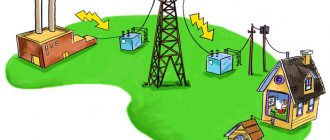What is ODN for electricity?
Every day a house that is connected to the power grid receives a certain amount of electricity from a resource organization. Part of the electricity is consumed by the residents of the house, this is called individual consumption. The other part of it is spent on servicing common building areas, which are not equipped with the same individual metering devices as apartments, and therefore are recorded only by a common building meter. This type of consumption is called communal consumption.
ODN is an abbreviation for the term “common house needs.” This is the amount of resource that is consumed to service the common areas of the house.
How to calculate ODNE in MKD using a meter
It is useful to know how to independently calculate the amount of payment for ODN for electricity. To do this, you need to know the area of the house, including utility rooms, the regional tariff and the readings of the common house and individual meters. Another calculation option applies to houses that do not have a common meter.
Examples of calculating the ODN of a multi-storey building
Let's consider both calculation options.
Without counter
In this case, the formula is used Viodn = Nodn x Soi (Si/Sob), where:
- Nodn – local consumption rate.
- Soi – area (utility).
- Si – apartment area
- Sob – area of the house.
The amount of energy after this calculation is multiplied by the tariff.
With counter
If there is a common flow meter in the house, another formula is used: Vi – Vd – Vnezh – Vlived b – Vlived – Vcr), in which:
- Vd – data of the general counter.
- Vnezh – electricity consumption in communal premises.
- Vlived b – consumption in apartments without a meter.
- Vlived – consumption in apartments equipped with a meter.
- Vcr – expense for additional services.
Of course, if you have a common house meter, the electricity consumption through the ODN is much lower.
What is included in the ODN for electricity?
Many residents, seeing the line ONE for electricity in their monthly payment receipts, think that this is payment for light bulbs in the entrances. In fact, the scope of application of electricity for general household needs is much wider.
In an apartment building, electricity is used both to maintain the entrances and to service the remaining areas associated with the building.
- operation of elevators;
- operation of intercoms;
- CCTV;
- lighting in the entrance and near the house;
- maintaining fire protection systems and other alarm systems.
At the same time, common areas include not only the internal spaces of the building, but also the external territory, where a parking barrier, an electronic gate, as well as security buildings can be located.
If the volume of one is negative
There are situations when the total expense is less than the apartment expense. This is possible if the house has several apartments that are not equipped with individual meters.
In this case, the Criminal Code, on the basis of Government Resolution No. 354, makes a recalculation to compensate for the difference in electricity costs.
Example of calculating a negative balance
For example, if the monthly difference between the ODPU and all MKD meters is 150 kilowatts per hour, they will be divided among all residents. If there are 200 residents, then 150/200 = 0.75 kW/h. This figure is then multiplied by the number of residents in the apartment. The total amount will go into the settlement document.
Payment for one electricity supply
Payment for electricity is made by the owners of the residential building. This payment procedure is prescribed in Government Decree No. 354.
The consumer of utilities in an apartment building, regardless of the chosen method of managing the apartment building, as part of the payment for utility services, separately pays for utilities provided to the consumer in residential or non-residential premises, and for utilities consumed during the use of common property in an apartment building home (hereinafter referred to as utilities provided for general house needs). “Rules for the provision of utility services to owners and users of premises in apartment buildings and residential buildings”, Decree of the Government of the Russian Federation dated May 6, 2011 No. 354
As follows from the Resolution, payments by owners for common building needs are made regardless of what form of management was chosen in the apartment building. Therefore, on a monthly basis, management companies of apartment buildings calculate the amount of resource that was spent on general building needs and include the corresponding column in the residents’ receipts.
Payment for one day
Since the costs of ODN are shared among residents, it is important to understand how they are calculated. A special formula is used for this: Pi = Viodn NS.
In it:
- Viodn – the share of ODNE per apartment.
- N is a standard approved by the local administration and expressed in kilowatt hours per square meter of area.
- S – apartment area.
Apartment owners often noticed an increase in these payments, which was difficult to justify with real changes in electricity consumption. This was due to violations by management companies.
How to calculate one rate for electricity
ODN for electricity is calculated in accordance with tariffs and standards approved by the regional government for each region. However, despite the difference in tariffs, the formula for calculating the one-time tariff for electricity is currently the same for everyone.
1. First of all, to calculate ODN, readings from the common house meter are taken. The house-wide meter records how much electricity was supplied to the house during the reporting period.
For example, let’s imagine that a common house meter showed that the house consumed 5,500 kWh during the current billing period. This is the total amount of consumption, which includes both individual consumption by residents and consumption for general household needs.
2. After the readings of the common house meter are taken, they are compared with the readings of individual metering devices. To do this, all the testimony that was given by the residents of the house is summed up. Typically, the period for collecting electricity readings is from the 23rd to the 25th of each month. Restrictions on the dates for taking readings are necessary to ensure that readings are taken as simultaneously as possible, which reduces discrepancies when balancing the balance of the house.
Let’s assume that the sum of all IPUs is 4,500 kWh. This is the amount of electricity that was consumed by apartment residents for personal purposes.
It is worth noting that today the collection of testimony from residents is becoming increasingly rare as a result of its extreme inefficiency and the inability to exclude the “human factor”. Judge for yourself:
- Residents do not always give evidence. Someone forgets, and someone goes on vacation or a business trip and does not physically have access to the meter. As a result, it is simply impossible to collect testimony from 100% of residents.
- The readings are transmitted with errors. Some people's eyesight fails, others their attention fails, and others simply have illegible handwriting. Therefore, when collecting testimony from residents, part of the testimony on the basis of which the calculation of payment for one-time tax is made is always erroneous. Not to mention the fact that unscrupulous residents may deliberately underestimate the readings of their metering devices.
- It takes hours, or even days, to process all the testimony received from residents, depending on how many houses and apartments the management company services. In light of the number of cases that require the attention of management companies, such time spent on processing evidence is simply irrational.
There are a number of other reasons why “manual” collection of readings is increasingly becoming a thing of the past, giving way to automated collection of electricity readings, which allows you to balance the entire house in 15 minutes with 100% accuracy.
3. After the residents’ IPU readings are collected and summarized, the resulting amount is subtracted from the general house readings. This makes it clear how much of the total consumption was spent by residents, and how much was spent on maintaining the common area of the building.
5,500 kWh - 4,500 kWh = 1,000 kWh. 1,000 kWh is the amount of electricity that was spent on general household needs during the reporting period.
4. In order to distribute the received ODN among the owners’ receipts, it is necessary to calculate how much general household expenses will be paid by each specific owner. This volume is calculated based on the area occupied by the owner. Therefore, to begin with, the ratio of one unit of ODN (in the case of electricity, this is 1 kWh) per 1 m² of living space is calculated.
For example, the living area of an apartment building is 5,600 m². In order to calculate the volume of one unit per 1 m², we divide the entire volume of one unit of 1,000 kWh by the entire living area of the house. 1,000 kW⋅h / 5,600 m² = 0.178 kW⋅h, this is exactly the volume of ODN per 1 m² of residential premises.
5. Having information about how much ODN is per 1 m² of residential premises, you can calculate how much ODN will be paid by each specific owner.
If the owner’s apartment has an area of 35 m², then multiplying the volume of one unit per 1 m² by this area, we get 6,230 kWh. This is the amount of ODN that will be paid by the owner with an apartment of 35 m².
6. Payment for ODN is calculated in accordance with the standards approved in the city or region.
If the electricity tariff is 5 rubles/kWh, then multiplying 6.230 kWh by 5 rubles, we get 31 rubles. 15 kopecks This is the amount of one tax paid by the owner with an apartment of 35 m².
The given formula for calculating ODN for electricity will be relevant if a common house meter is installed in the house. If a common house meter is not installed, ODN is paid according to the standards using increasing factors.
In the absence of a collective (common house) metering device for cold water, hot water, electrical energy and thermal energy (if it is technically possible to install such metering devices), the payment for utility services provided for general house needs for the billing period is calculated using the increasing factors provided for Rules for establishing and determining utility consumption standards approved by the Government of the Russian Federation, Decree of the Government of the Russian Federation dated 05/06/2011 No. 354
We invite you to familiarize yourself with the information material on the issue of consumption and payment for electricity used for general household needs.
What is general household consumption?
General house needs (hereinafter referred to as GDN) are electricity consumed for lighting entrances, basements, attics, operating fire-fighting automatics, access lamps, antenna amplifiers, intercoms, pumps pumping water to the upper floors of the house, and other electrical equipment necessary to create comfortable living conditions in house and is the common property of all residents. In addition, technological losses in intra-household networks are also paid for as general household consumption.
What are power losses?
Electricity is a resource that does not require additional resources to move it over a distance—it consumes part of itself. When transmitting electricity through an electrical network, technological energy consumption is inevitable in its elements, due to the active resistance of the circuit.
Losses in networks arise due to theft of electricity, due to deterioration of electrical wiring, as well as errors in taking readings of individual meters or deliberate distortions of records.
In old housing stock, where intra-house electrical networks are characterized by a high level of wear and tear, the electrical wiring has not been replaced, and the level of electricity losses is usually quite high. Therefore, it is primarily the residents of the building who are interested in upgrading power lines in order to adapt them to modern network load levels.
Why should I pay for household consumption?
The owner of an apartment in an apartment building, along with the apartment, also owns a share of the common property of the house, which is proportional to the size of the total area of the apartment.
Therefore, the owner (tenant) of an apartment is obliged to pay not only for individual electricity consumption, but also for electricity consumption for general house needs.
Where is the general house meter installed and who takes readings from it?
Common house metering devices (CDMU), as a rule, are installed at the border of electrical networks included in a residential building. If there are several such inputs into a house, then they are all equipped with separate common house metering devices, the volume of supply for which is summed up in further calculations. You can find out about the specific location of a common house appliance from the management company.
ODPU readings are taken monthly by employees of the network organization or management company.
How is the volume of ODN in an apartment building determined?
If there is a common house (collective) metering device, from the electricity consumption according to the collective (common house) metering device installed at the entrance to the house, the electricity consumption according to individual (apartment) meters and the amount of electricity consumed by citizens who do not have meters, determined according to the standards, are subtracted. If there are non-residential premises in a multi-apartment residential building (shops, pharmacies, etc.), their consumption volume is also deducted from the consumption of a common building meter.
Step 1 - readings of the common house meter are taken on the last day of the month. Let’s say the volume of electricity determined by a common house meter was 36,120 kWh.
Step 2 - the readings of all apartment meters in the house are taken and summed up, the volume according to the standard in apartments where metering devices are not installed, as well as the consumption volumes of legal entities, which are counted from the input meter. Let's assume this volume is 24,573 kWh.
Step 3 - the expenses for the needs of the house are established. This is the difference between the volume of electricity according to the general house meter and the volume of consumption of all residential and non-residential premises (36,120 kWh - 24,573 kWh = 11,547 kWh).
Step 4 - the difference (11,547 kWh) is divided by the area of all living spaces in the house. Let's say the area is 9,822.39 m2. The result of the calculations is 1.175 kWh/m2.
Step 5 - multiply the resulting figure by the area of a specific apartment (for example, 37 m2) and the current tariff (3.14 rubles in houses with gas stoves). Result: owners of an apartment with an area of 37 m2 will pay for electricity consumption for the needs of the entire house 37 m2 * 1.175 kWh/m2 * 3.14 rubles/kWh = 136.51 rubles.
In the absence of a common house (collective) metering device, the volume of ODN is determined according to the standards established from January 1, 2013 by Order of the Commission for State Regulation of Prices and Tariffs in the Belgorod Region No. 17/28 dated August 30, 2012. Apartment buildings not equipped with an elevator - 0, 37 kWh per 1 m2 of total area of premises included in the common property in an apartment building.
Apartment buildings equipped with an elevator - 0.51 kWh per 1 m2 of total area of premises included in the common property in an apartment building.
What influences the value of ODN?
If there is no collective metering device in an apartment building and the consumption of the apartment building is determined according to the consumption standard, the value of ODN depends on:
— on the reliability of information about the total area of premises included in the common property of an apartment building;
- on the reliability of information about the total area of each residential and non-residential premises in an apartment building.
If there is a collective metering device in an apartment building, the value of ODN is affected by:
— the reliability of the readings of the individual meter for each apartment and for each non-residential premises on the last day of the current month;
— the state of the instrument stock of individual metering devices in residential premises (apartments). At the moment, most of the metering devices used by citizens to pay for individual consumption have an expired calibration interval;
- cases of unauthorized connections to common building electrical networks of commercial facilities, for example, car parks, stalls, sheds located next to an apartment building, or the presence of non-residential premises on the first floors of houses, the owners of which have not concluded an energy supply agreement with either the management company or the guaranteeing supplier ;
- dilapidated electrical networks of an apartment building.
How to reduce the value of ODN?
1. Owners of residential premises should replace metering devices with expired verification intervals, and install meters for those who do not have them. It should be remembered that electricity consumption standards are averaged, and with readings taken from the apartment meter, the shares of ODN will be distributed more accurately. Moreover, according to Federal Law No. 261
Before July 1, 2012, citizens were required to install apartment meters at their own expense that meet certain technical requirements. With a mass approach, such measures will reduce payments for electricity consumed for general household needs by up to 10%.
2. The general meeting of the residents of the house must make a decision to empower persons from among the owners of apartments in the house (the head of the house or the entrance or members of the house council), who will take readings in each apartment every month from the 28th to the 31st of the current month and provide this information to the subscriber point of OJSC Belgorodenergosbyt no later than the 2nd day of the month following the billing month. Accurate accounting will allow you to reduce the value of ODN to 15%.
3. Carry out a wiring audit (energy audit) and, together with the company servicing intra-house networks, identify unscrupulous consumers of electricity connected to the network bypassing meters. For example, with the participation of representatives of the management company, who, if not themselves, then by attracting a specialized company with appropriate personnel certified to work in electrical networks, will carry out all this work.
4. In order to increase the energy efficiency of housing, install lighting devices above the entrances that are connected through automatic lighting sensors, replace incandescent lamps everywhere with energy-saving ones, and install motion sensors on staircase landings.
I heard that citizens do not have the right to charge more than the standard for communal electricity. Who pays for the balance?
In accordance with clause 44 of the Decree of the Government of the Russian Federation dated May 6, 2011. No. 354 “On the provision of utility services to owners and users of premises in apartment buildings and residential buildings” from 06/01/2013, the volume of utility services consumed at the one-room service station cannot exceed the volume of utility services calculated based on consumption standards. The exception is the adoption by the owners of the premises at a general meeting of a decision on the distribution of the volume of utilities exceeding the standard consumption on one unit among all owners in proportion to the occupied area.
If such a decision is not made by the owners, the difference between the volume of utilities determined based on the readings of the collective (common house) meter and the volume calculated based on utility consumption standards, the management company pays from its own funds . In this regard, for example, there was a need to adjust the existing settlement scheme between OJSC Belgorodenergosbyt and management companies of the Stary Oskol urban district.
The possibility of a repetition of such a situation should encourage the management company to deal with the problems of minimizing electricity losses inside an apartment building.
In the case of a direct form of house management, an unselected management method or non-contractual consumption, as well as in the event of a corresponding decision being made by the general meeting of owners, the entire volume of electricity supplied to the house is distributed
in proportion to the size of the total area of each residential and non-residential premises. In this case, the residents of the house are interested in energy saving measures. Although in the option with a management company, the owners are also primarily interested in energy saving, because The costs of management companies to pay for excess energy consumption can ultimately still be passed on to residents as part of the housing maintenance tariff.
Do the owners of non-residential premises in an apartment building (shops, cafes, hairdressers, etc.) pay for electricity on the one-room heating network?
The owner of non-residential premises in an apartment building is obliged to make payments for electricity consumed for general house needs.
In this case, the volume of electricity for general house consumption is determined in proportion to the occupied area of premises in an apartment building, and the cost of electricity is calculated based on the tariffs established for the corresponding group of consumers.
I suspect there is a shoe shop connected to our house. What to do?
Contact your property manager with a free-form application (don’t forget to leave your contact details), and together with the management company and representatives of the residents, the legality of connecting the shoe shop will be checked. If unauthorized connections are detected, the charge for one-way access will be recalculated for both residents and legal entities located in the apartment building, depending on the connection scheme.
If illuminated advertising is installed on the house, is the electricity cost for its operation also taken into account by the general house meter?
Before installing such advertising, the management company must obtain the consent of the owners, and then agree on a separate connection point with the electricity supplier. Then the costs of illuminated advertising will not be taken into account in the overall balance of energy consumption at home.
Are neighbors' debts taken into account when allocating household electricity consumption to respectable citizens?
No. Each citizen pays for consumption according to his individual metering device installed in his apartment, and his share of the general household consumption, determined in accordance with the Rules for the provision of utility services.
All legal measures of influence are personally applied to each debtor: restriction of electricity supply and collection of debt in court.
What happens if a citizen pays for electricity using his apartment meter, but does not pay for one?
Federal legislation provides for the same liability for refusal to pay for general household needs as for refusal to pay for energy consumed in an apartment. Both payment for ODN and payment for intra-apartment electricity consumption relate equally to the energy supply service.
Will they recalculate my one-time allowance for the period of temporary absence from the apartment?
In such cases, the amount of payment for electricity consumed for general house needs is not subject to recalculation.
Should a social renter pay for electricity for common building needs?
Yes. Resolution No. 354 says “... owner (tenant) …”
Do benefits apply to the payment of single-payer expenses?
According to federal legislation, benefits are monetized, and charges for intra-apartment consumption and for one-time tax credits are billed to all consumers in full.
Accordingly, citizens who have benefits for paying for energy supply services receive monetary compensation in the amount of the established standard, depending on the category of benefit. The local social security authority is responsible for calculating benefits.
Is it possible to save money on lighting the local area and common areas? For example, turn off the lights at night when everyone is sleeping?
Requirements for living conditions in residential buildings and premises, including the illumination of the local area and common areas, are approved by the Resolution of the Chief State Sanitary Inspector of the Russian Federation dated June 10, 2010 No. 64 “On approval of SanPiN 2.1.2.2645-10.” Introducing lighting restrictions in violation of these standards will be contrary to current legislation.
In addition, the Decree of the State Construction Committee of the Russian Federation dated September 27, 2003 No. 170 “On approval of the Rules and Standards for the Technical Operation of the Housing Stock” defines the requirements for the condition of staircases. Including their mandatory lighting (clause 4.8.14).
According to clause 5.6.17 of the said resolution, switches with a time delay for shutdown are allowed to be used in houses to turn on work lighting fixtures in common premises.
When using the specified switches, the lighting in the entrance hall (on the first floor near the stairs) must remain on during the entire dark time of the day, and in case of insufficient natural light, also near the elevators. When using switches with a time delay to turn off, they must be installed on each floor, ensuring the possibility of prompt switching on to a constant operating mode while cleaning the staircase, moving furniture, etc.
Based on the foregoing, the introduction of restrictions on lighting in the local area and public places is contrary to current legislation, since it may cause harm to the life and health of citizens.
But, for example, a general meeting of owners of premises in an apartment building, in order to reduce energy consumption, may decide to install and use energy-saving equipment. March 11, 2014
How is the calculation made for each consumer?
There are two different ways to calculate the payment per consumer. They differ in the accuracy of the final amount. The choice depends on the availability of a general meter for electricity consumption in the apartment building.
If there is a communal meter
If there are readings from two sources, calculations are carried out according to the following logic:
- The total light consumption of all apartments per month is calculated.
- The total consumption of residents is subtracted from the readings of the common house meter.
- The resulting amount is divided among all apartments taking into account their total area.
Thus, each person receives a payment slip with accurate data on electricity consumption for the previous month. Some injustice of this method is that when distributing expenses, the area of the apartment is taken into account, and not the number of registered people. However, this method is more acceptable to users due to its accuracy.
Hint: the difficulty of using general house readings is the need to collect readings from apartment meters. Without them, it is not possible to calculate the readings.
You need to know that utility services do not focus on exact figures for resource consumption, but on internal consumption formulas. Based on data for the last twelve months, they determine the average consumption. Based on its value, the payment for the previous period is calculated.
If there is no common appliance in the house
The lack of accurate accounting of resource consumption led, until the beginning of 2017, to an increase in electricity charges for ODN to a level of 30%. This does not correspond to real indicators of resource consumption. Therefore, the Government of the Russian Federation made the following change to the methodology:
- the authorities of the constituent entities of the federation are obliged to establish increasing coefficients for buildings of various types;
- these should be brought to the attention of: utility services that charge amounts for consumed resources;
- population.
Thus, the authorities took the path of unifying charges. The use of a multiplying factor does not reflect actual electricity costs. However, the rule allows utilities to limit the amount they charge for general consumption.
Calculation formula
To determine the payment amount for each apartment, it is necessary to establish the relative area of usable space used. This is done according to the formula given in the government decree. She is like this:
Rozh = Norm x Poo x (Pkv / Pob), where:
- Norm - coefficient established by the regional government for a given type of building; Poo - common area;
- Pkv - apartment size;
- Pb - the area of the entire building.
The formula is contained in Appendix 2 to the Decree of the Government of the Russian Federation No. 354 (subject to change).
E/e ODN for non-residential stock
It’s not only apartment owners who have to pay ODN. This obligation also applies to owners of non-residential premises. Therefore, apartment owners should not worry about the cost of electricity, for example, for a hairdresser located on the ground floor of an apartment building, since the payment for electricity supply is carried out equally from both apartment owners and those who own non-residential premises. The main parameter on which calculations are based is the area of the occupied premises, and not the status.
Excessive power consumption
If consumption exceeds the norm, this is equivalent to theft, because this is possible when connecting to the electrical network, bypassing the electricity meter. In apartments where there is no individual meter, the ODN is calculated based on the number of residents and registered residents. In this case, it happens that many times more people actually live than according to the documents. Little things also have an impact, such as the submission of readings from measuring instruments not on time and their falsification, instrument errors, and intra-house losses.










